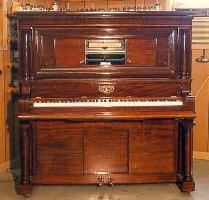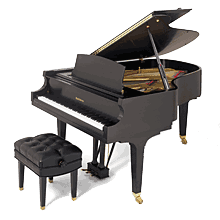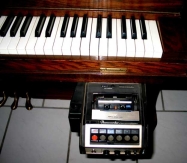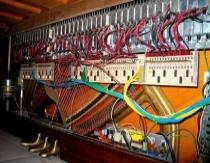| Pianos Without Pianists |
| Upright Player Piano, 1923-25 Maker: Gabler & Bros New York, NY |
| Around 1905, the upright player piano emerged, with all the player mechanisms built right in to the piano's cabinet. During the 1920s, production of player pianos outpaced normal piano production in the US as the instrument began to compete with the ever growing popularity of electronic media. |
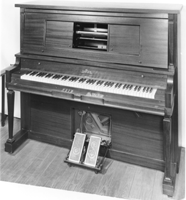
| Upright Player Piano c. 1925 Maker: Brinkerhoff Chicago, Illinois |
| Pianola Piano Player, 1900-1905 Maker: Aeolian New York |
| The forerunner to the upright player piano, "the push-up" piano player was a separate mechanism and cabinet that was pushed up to piano keyboard. Wooden fingers would then strike downwards to play the piano keys. |
| Pianola With Piano in position to play |
| Reproducing Piano, c. 1924 Maker: Stodart New York |
| Introduced in 1904, perhaps the most sophisticated, but expensive, form of playing mechanism was the "reproducing" piano. These pianos, unlike their upright player piano counterparts, were capable of "reproducing" the nuances of an artist's keyboard touch. After George Gershwin recorded the master roll of "Rhapsody In Blue" he stated that this roll represented his exact playing and tonal nuances. In other words, the playing mechanism was capable of striking each note with varied intensity and speed. |
| © 2000-2021 Concert Pitch Piano Services. All rights reserved. |
| . |
| . |
| . |
| CONCERT PITCH PIANO SERVICES |

| . |
| Pianocorder, c. 1977 Maker: Teledyne Sold by: Sony/Superscope/Marantz California |
| Modern technology - electronic rather than pneumatic - witnessed a significant late 20th century resurgence of interest in the acoustic piano as a reproducing instrument. In 1977, Teledyne built an electronic solenoid operated piano playing system retrofit (replacing the old pneumatic player systems) that was sold by Sony/Superscope/Marantz. It was named Pianocorder. The Pianocorder was an electronic player piano mechanism that, by means of a digitally encoded cassette tape, could record or play a "live" performance on any piano in which it was installed (using material from the old Welte, Duo-Art and Ampico player piano roll catalogues), the output of which was fed to keyboard solenoids. Marantz used to make some of its pianos with Pianocorder installed, some without, and separate Pianocorder kits that could be installed in any piano. In 1979 Gary Burgett, a music teacher in Sacramento, CA, and his brother Kirk, a machinist and piano rebuilder, opened a store together in Nevada City, CA. In 1984 they secured the Pianocorder electronic player piano system franchise. In 1987 Yamaha acquired Pianocorder, and the Burgetts' store closed down. Almost immediately the brothers began to design and manufacture their own electronic player piano system, PianoDisc, and in 1989 they produced the first model. PianoDisc continues to thrive, retrofitting their electronic player piano system in any brand of pianos and over the years many generations of PianoDisc player systems have been introduced, each one expanding the capabilities and features of the last. When Yamaha purchased Pianocorder and its technology in 1987, they developed their own player piano system: the Disklavier. At the same time, QRS Music Technologies was developing its own player piano system, Pianomation. QRS was founded in 1900 in Seneca, PA by Melville Clark (of Story & Clark piano fame) who developed the player piano as we know it today. QRS supplied music rolls to the player piano market. In 1986, QRS began focusing on new technologies, and in 1989 released its first digital retrofit player piano kit under the Pianomation name. Today QRS is an industry leader in introducing innovations in home musical entertainment. |
| | EXPERIENCED |
| CERTIFIED |

